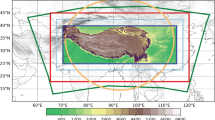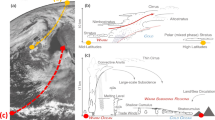Summary
The response of the climatic system to changes in its radiative forcing has been the subject of much study. Climate models of various complexity have been used to demonstrate that a small increase in the solar constant, or doubling of the atmospheric CO2, would lead to a warmer surface. Very little scientific attention, however, has been given to the effect such a change in radiative balance might have on climatic variability. That is, would an earth warmed in this way be more temperate or more variable? To move one step closer to answering this question, we employed a simple one-dimensional surface energy balance climate model and forced it with random Gaussian white noise to simulate interannual variability. We integrated the model using 0, 2, and 4% increases in the solar constant. The results of these numerical experiments indicate that, under a warmer surface radiative balance, interannual variability of the surface temperature is reduced.
Similar content being viewed by others
References
Angell, J. K., Korshover, J., 1978: Global temperature variations, surface — 100mb: An update into 1977.Mon. Wea. Rev. 106, 755–770.
Asakura, T., Ikeda, S., 1981: Recent climate change and unusual weather in the northern hemisphere.Geo. J. 5, 113–116.
Boer, G., Higuchi, K., 1980: A study of climatic variability.Mon. Wea. Rev. 108, 1326–1332.
Boer, G., Higuchi, K., 1981: Seasonal climatic variability.Atmosphere-Ocean 19, 90–102.
Bolin, B., Jäger, J., Döös, B. R., 1986: A synthesis of present knowledge. In:Greenhouse Effect, Climatic Change and Ecosystems (eds. B. Bolin, B. R. Döös, J. Jäger, and R. A. Warrick), 1–32, SCOPE 29, New York: Wiley and Sons.
Gal-Chen, T., Schneider, S. H., 1976: Energy balance climate modelling: Comparison of radiative and dynamic feedback mechanism.Tellus 28, 108–121.
Hansen, J., Lacis, A., Rind, D., Russell, G., Stone, P., Fung, I., Ruedy, R., Lerner, J., 1984: Climate sensitivity: Analysis of feedback mechanisms. In:Climate Processes and Climate Sensitivity (eds. J. E. Hansen and T. Takahashi), 130–163, Geophysical Monograph 29, American Geophysical Union, Washington, DC.
Hunt, B., 1988: Nonlinear influences — a key to short-term climatic perturbations.J. Atmos. Sci. 45, 387–395.
Jones, P. D., Wigley, T. M. L., Kelly, P. M. 1982: Variations in surface air temperatures: Part 1. Northern hemisphere, 1881–1980.Mon. Wea. Rev. 110, 59–70.
Nicolis, C., 1988: Transient climatic response to increasing CO2 concentration: some dynamical scenarios.Tellus 40 A, 50–60.
Schlesinger, M., 1986: General circulation model simulations of CO2-induced equilibrium climate change. In:Impact of Climatic Change on the Canadian Arctic (ed. H. M. French), 15–51, Proceedings of a Canadian Climate Program Workshop, March 3–5, 1986, Geneva Park, Ontario, Canada.
Sellers, W. D., 1973: A new global climate model.J. Appl. Meteor. 12, 241–254.
Shabbar, A., 1979: Experiments with a time-dependent, zonally averaged seasonal, energy balance climate model and an examination of radiative and dynamic feedback mechanisms. M.Sc. Thesis, University of Toronto, Toronto, Ontario, 111 pp.
Oeschger, H., Stauffer, B., Finkel, R., Langway, C. C., Jr., 1985: Variations of the CO2 concentration of occluded air and of anions and dust in polar ice cores. In:The Carbon Cycle and Atmospheric CO 2 :Natural Variations Archean to Present (eds. E. T. Sundquist and W. E. Broecker), 132–142, Geophysical Monograph 32, American Geophysical Union, Washington, DC.
van Loon, H., Williams, J., 1978: The association between mean temperature and interannual variability.Mon. Wea. Rev. 106, 1012–1017.
Author information
Authors and Affiliations
Rights and permissions
About this article
Cite this article
Higuchi, K., Sargent, N.E. Response of a stochastically-perturbed 1-D surface energy balance model to increased temperature. Theor Appl Climatol 41, 117–120 (1990). https://doi.org/10.1007/BF00866434
Received:
Issue Date:
DOI: https://doi.org/10.1007/BF00866434




